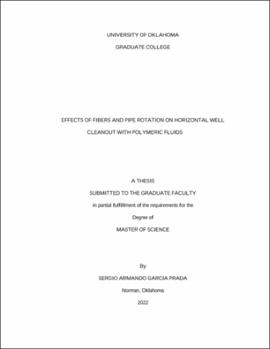| dc.description.abstract | Rock cuttings deposition is a problem commonly faced during drilling, completion, and
intervention activities. Using polymer-based fluids is the to-go technique to improve horizontal
hole cleaning. However, the rheological properties of such fluids are sometimes not enough to
guarantee an efficient cleanout. One of the ways to improve cleanout efficiency is by rotating the
pipe inside the annulus to mitigate the settling of solids. Another approach is by adding fibers to
the cleaning fluid, improving its lifting capacity and moving the settled solids. This study is aimed
at evaluating the cleanout performance of polymer-based and fibrous fluids in horizontal wells
without and with pipe rotation using a large-scale flow loop.
The flow loop consists of a 48-ft long annular test section with a 5-in. ID wellbore and an
inner 2.375-in. OD drill pipe. In each experiment, a solids bed of natural proppant is placed in the
annulus. Low-viscosity polymeric suspensions are used as the drilling fluid with and without fiber.
Flow rate and pipe rotation are varied while measuring the equilibrium bed height. The initial bed
height is placed at a flowrate of 35 GPM without pipe rotation. Then, the flow rate is increased
step by step until the bed is completely cleaned. The measured test parameters include the bed
height along the horizontal annulus, flow rate, pipe rotation speed, and pressure loss, monitored
and recorded using a data acquisition system. A rotational viscometer is used to monitor the
rheology of the fluids.
The results show that fiber improves the effectiveness of hole cleanout in horizontal
wellbores. When a small amount of fiber (0.04% wt.) is added to the base fluid, the cleanout
performance improves significantly. Despite negligible impact on the rheological characteristics
of the fluid, the fiber improves the solid lifting capacity to induce motion in the settled bed particles
in horizontal well configurations. The addition of fiber causes a lack of homogeneity in the bed
profile, an effect known as duning. The presence of pipe rotation also shows excellent cleanout
efficiencies. In some cases, even the slightest rotation speed is enough to obtain almost complete
cleanout at significantly lower flowrates.
The experimental results were compared to mechanistic models predicting the pressure
drop and the bed height, and showed an acceptable agreement. The presence of dunes increases
the error in the pressure drop prediction because the model assumes a uniform bed height. A
correction factor is developed to mitigate the duning effect, giving new pressure drop predictions
within an acceptable error range. The results of the bed height prediction are excellent for the base
fluid and inferior for the fibrous fluid. A sensitivity analysis is done for the mechanistic model,
identifying the most important predictor parameters. | en_US |
